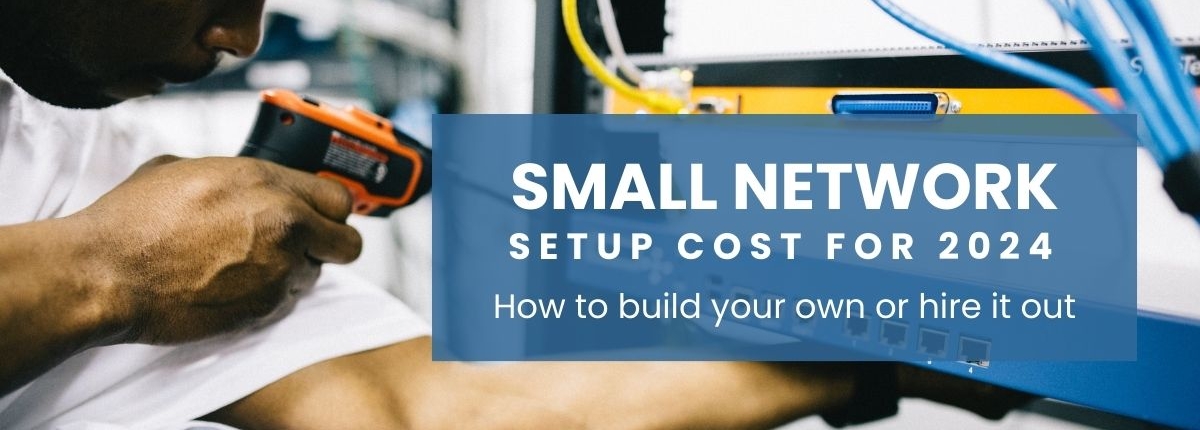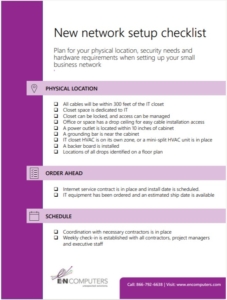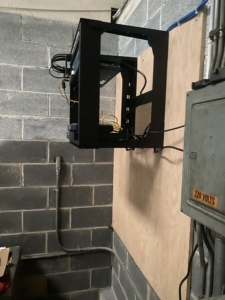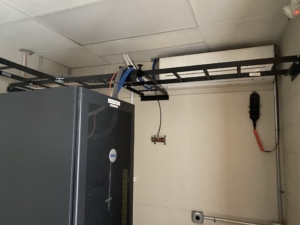

Director of Technology, E-N Computers
20+ years experience in enterprise IT and managed services.
Your small business has grown to the point you need a network, or you’ve opened a new branch office and you want to know what it will cost to set up a network on site. You’ve come to the right place for the answer.
And here’s the bottom line: whether you DIY your network or outsource the job, a typical 24-port small business network will cost you around $5,540 to set up in 2023.
This includes standard networking hardware, wi-fi and some basic construction supplies. It doesn’t include the potential costs of HVAC or electrical work, the cost of internet service or the cost of your time.
The biggest cost factor with any network setup is the number of devices. The biggest wasted cost is buying internet speed that is beyond what you need.
We’ll give you a detailed small business network installation cost estimate. This will outline what’s involved in that installation cost and what you would need to set up a network yourself. We’ll even give you links to specific hardware we know to be reliable. We also warn you about a couple of hidden unnecessary costs, potential sources of unnecessary delays, and provide some options for outsourcing the work.
As a managed IT service provider, E-N Computers has set up small networks for more than 20 years. With our detailed checklist, you can practically set up a small network closet yourself.
If you’re primarily interested in the costs of small business IT, you might want to check out our related articles.
READ: How much do outsourced IT services cost in 2024?
QUICK ANSWER:
How much does it cost to install a small business network?
A typical 24-port network will cost you around $5,540 to set up. This includes standard networking hardware, wi-fi and some basic construction supplies. It doesn’t include the potential costs of HVAC or electrical work, the cost of internet service or the cost of your time. We’ll give you a detailed outline for what’s involved in the installation cost.
Get internet service
You might not expect this to be your first step on a checklist for a small network installation but if you don’t have internet service, you will want to get started with that ASAP, particularly if you’re setting up a new building. Getting internet service to new construction can take 30-120 days depending on the provider and where you’re located.
We’ve seen companies get a building completely ready to move into and only then think about internet service. It has literally taken 120 days to dig a trench. Nobody wants to wait almost half a year just to get internet.
What kind of internet service provider should you look for? We could say a lot about this topic alone. But for now, consider these factors: how you’ll use the internet, the number of users and devices, and the internet speed you’ll really need.
Fiber or cable?
Internet service can be DSL, fiber or cable. We don’t recommend DSL. Fiber has the advantage of having the same upload and download speed. Cable tends to have faster download speeds and slower upload speeds.
The type of service that’s best for you depends on whether you need a fast upload speed. Are you going to be moving large amounts of data out of your network, perhaps as backups to the cloud? Or are you mostly working in the cloud? If you can get by without fast upload speeds, cable will be fine.
What speed? (And think about your firewall)
For a small site of 24 users, a 100- to 500-megabit connection should be fine.
Besides the number of users, another factor is the capacity of your firewall. We’ve seen companies spend on expensive internet connections, but their firewall can’t handle the speed.
You’re wasting money paying for a gigabit of data from an ISP but then running it through a firewall with a 500-megabit capacity. Sometimes IT managers get stuck with a three-year or five-year contract for internet that they can’t even use. It’s not unusual to talk to prospective customers whose MSP said to buy both the fast internet and the lower capacity firewall at same time because they didn’t understand what they were selling.
Getting a firewall that can handle a gigabit is going to be substantially more expensive. A Meraki firewall for that speed would be about $10,000. In comparison, the Meraki firewall and license we recommend for a 500-megabit connection is about $1,000. So, when considering the cost increase from a 500-megabit to 1-gigabit connection, don’t forget to factor in the cost of the firewall.
Get the Network Setup Checklist

Use our downloadable checklist to plan and execute your small business IT network installation. Or use it to investigate pricing with a good IT services contractor.
Don’t have time to fill out the checklist right now? Enter your email address (totally optional!) and we’ll send you a link so you can download it later or share it with your team.
Identify the location for the network closet
When selecting the location for your IT closet, keep the following things in mind:
Cable length
Network cables going from your network closet to your offices (called ‘ethernet drops’) should not be more than 100 meters. Running them longer can reduce network speed. For this reason, you usually want to keep the IT closet centrally located. This would allow your cables to travel roughly 300 feet in any direction. This may not be an issue in a small office.
Also consider where you will run your cable. If your office doesn’t have a drop ceiling, look for an attic or crawlspace.
Your lease and permits
If you’re leasing your office space, you may need to get permission to make changes in order to run your cable. For example, if you don’t have a drop ceiling or attic, you might need to run cable through conduit attached to walls or ceilings. Also, large cities may require a permit to make changes.
Security
Your IT closet should be in a secure location. Ideally it should be locked. If your IT closet ends up in a shared space, you should buy an IT equipment cabinet that has a lock.
Prepare the IT closet
Backer board
You’ll need to attach a cabinet to the walls of the IT room, whether they are concrete, concrete block or traditional 2 x 4 or metal studs with paneling or drywall. Generally, this is done with a ¾” plywood backer board. These boards can be purchased in 2 x 2 or 2 x 2 pre-cut sheets at Lowe’s or Home Depot. If you are doing multiple sites, you might want to get a full 8 x 4 sheet of plywood.
If you are attaching your backer board to concrete or block, Tapcon anchors work well for this. If you are attaching to a traditional wall, use some lag bolts. You will also likely need a stud finder. With any of the walls, I highly recommend using Liquid Nails for added strength to secure the board to the wall.
Power
Before attaching anything to the wall, make sure you have a power receptacle in place. If you don’t have power available, you will need to work with an electrician to get it. A power receptacle needs to be within about 10 inches of where your cabinet is installed.
Grounding
When you’re building out an IT closet, think about potential risks. Grounding out the cabinet is critical. We also recommend that other network devices coming from outside the building like cameras or wireless access points receive a grounded surge protector.
Heating and cooling
Ideally your IT closet should maintain a temperature of 65-70 degrees Fahrenheit. You don’t want to be blowing hot air into a small IT room during the winter months, and you want to keep it cool during the summer months. Have the room in a separate HVAC zone. If that is not an option, often the ductwork can be blocked off, and a mini-split unit can be installed. If you’re a do-it-yourselfer, MRCOOL is a good option. We have also had good success with Trane/Mitsubishi products.
Design the layout
Take into consideration how many cable drops will be needed for the following items:
- Printers
- Computers
- Servers
- Digital video recorder
- Security cameras
- VoIP phones
- Wireless access points
- Door access controls
- Paging systems
Use an existing floor plan if possible and mark where the cables need to go. This should also provide an idea of the amount of cable needing to be purchased. We recommend cat 6 cable for the best data speed for a smaller office. Depending on the HVAC system and local code, it will need to be plenum cable, which has a safe type of insulation in the event of a fire or smoke traveling through the HVAC. Plenum will double the cost of a box of cable from around $200 to around $400.
The IT cabinet size will be based on the number of cables that are needed for your organization.
You will need the following items for building out an IT cabinet (with ballpark pricing):
| Patch panels | $60 |
| Cable management | $85 |
| Cables and connectors | $800 |
| Network switch | $2,245 (includes license) |
| Network firewall | $1,200 (includes license) |
| Battery backup | $445 |
| Surge protector | $52 |
| Shelves for your modem or fallover internet modem | $50 |
| Internet modem | Provided by ISP |
| Failover or secondary internet modem | Provided by ISP |
| Wireless access point | $600 (includes license) |
Total: $5,537
Once you have completed the initial discovery, you are ready to place a technology order for equipment and supplies. Along with our downloadable checklist, we provide full pricing and specifications on our preferred items for a 24-port buildout in PDF format.
Install the network
You may decide to do all the work yourself or you may want to outsource all or part of the network installation.
If you have an internal IT manager or team, they might have the time and expertise to set up the entire network and configure the equipment. However, even IT people don’t run cable every day, so they’ll be much slower than a low-voltage contractor who runs cable all the time. This could be fine if you’re not in a hurry and you don’t mind someone like a high-salary IT manager running cable. However, your time spent on running cable and on managing the project will add up and may cost your organization more than if you just outsourced.
For some details on how to configure your new firewall, see our network firewall replacement checklist.
If you don’t have an internal IT manager or team, then your best option is to outsource the installation and setup of your network.
An outsourced IT company like ours can hire contractors, set up the project management, coordinate with the ISP and possibly set up networking monitoring and ongoing management, all of which could be more cost and time effective than doing it yourself even if you already have an internal IT team. We also have done these projects repeatedly, so we know what problems to avoid and where costs can be saved.
If you’d like to go over a small business network installation with an experienced engineer, let’s talk. If you successfully set up your own network with some help from our checklist, we’d love to hear about it.
Take the IT Maturity Assessment

Is your business ready to weather changes, including employee turnover? Find out by taking our IT maturity assessment.
You’ll get personalized action items that you can use to make improvements right away. Plus, you’ll have the opportunity to book a FREE IT strategy session to get even more insights into your IT needs.

Industries
Locations
Waynesboro, VA
Corporate HQ
215 Fifth St.
Waynesboro, VA 22980
Sales: 540-217-6261
Service: 540-885-3129
Accounting: 540-217-6260
Fax: 703-935-2665
Washington D.C.
1126 11th ST. NW
Suite 603
Washington, DC 20001-4366
Sales: 202-888-2770
Service: 866-692-9082
VA DCJS # 11-6604
Locations
Harrisonburg, VA
45 Newman Ave.
Harrisonburg, VA 22801
Sales: 540-569-3465
Service: 866-692-9082
Richmond, VA
3026A W. Cary St.
Richmond, VA 23221
Sales: 804-729-8835
Service: 866-692-9082


